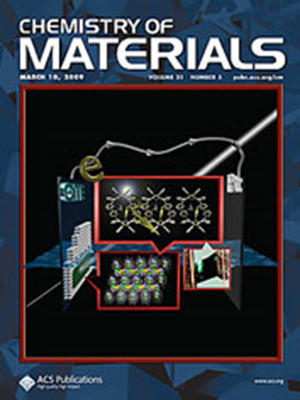Enhancing Thermoelectric Efficiency in GeTe via Tailored Alloying and Band Engineering
IF 7
2区 材料科学
Q2 CHEMISTRY, PHYSICAL
引用次数: 0
Abstract
The development of advanced thermoelectric materials stands as a cornerstone in the pursuit of sustainable energy technologies, offering transformative potential for waste heat recovery and renewable energy systems. Despite the promising attributes of GeTe as a midtemperature p-type thermoelectric material, its practical efficiency remains constrained by inherent challenges, namely, its high lattice thermal conductivity and suboptimal carrier concentration. In this study, we introduce an innovative dual-strategy framework that seamlessly integrates tailored alloying and band convergence to achieve a profound decoupling of electrical and thermal transport properties in GeTe. Through systematic investigations of Se and Pb alloying, we demonstrate that Se alloying effectively reduces lattice thermal conductivity by enhancing phonon scattering, while maintaining superior carrier mobility─outperforming Pb alloying in this regard. Moreover, the strategic incorporation of Sb doping at Ge sites not only refines carrier concentration to optimal levels but also enhances crystal symmetry, thereby fostering valence band convergence and significantly elevating the Seebeck coefficient─a critical metric for thermoelectric performance. The synergistic implementation of these advanced strategies culminates in the optimized composition Ge0.9Sb0.1Te0.9Se0.1, which attains a remarkable peak ZT value of approximately 1.8 at 773 K and maintains an impressive average ZT of 1.1 across the temperature range 300–773 K. These results underscore the transformative impact of our approach on achieving state-of-the-art thermoelectric performance. This work illuminates the pivotal role of tailored alloying and symmetry-driven band engineering in advancing thermoelectric materials.

通过定制合金化和条带工程提高GeTe的热电效率
先进热电材料的发展是追求可持续能源技术的基石,为废热回收和可再生能源系统提供了变革潜力。尽管GeTe作为中温p型热电材料具有很好的特性,但其实际效率仍然受到固有挑战的限制,即其高晶格导热率和次优载流子浓度。在这项研究中,我们引入了一种创新的双策略框架,该框架无缝集成了定制合金和能带收敛,以实现GeTe的电和热输运性质的深刻解耦。通过对硒和铅合金的系统研究,我们证明了硒合金通过增强声子散射有效地降低了晶格热导率,同时保持了优越的载流子迁移率,在这方面优于铅合金。此外,在Ge位点战略性地掺入Sb掺杂不仅可以将载流子浓度提高到最佳水平,还可以增强晶体对称性,从而促进价带收敛并显著提高塞贝克系数──热电性能的关键指标。这些先进策略的协同实现在优化的组合物Ge0.9Sb0.1Te0.9Se0.1中达到顶峰,该组合物在773 K时达到了约1.8的峰值ZT,并且在300-773 K范围内保持了令人印象深刻的平均ZT 1.1。这些结果强调了我们的方法对实现最先进的热电性能的变革性影响。这项工作阐明了定制合金化和对称驱动带工程在推进热电材料中的关键作用。
本文章由计算机程序翻译,如有差异,请以英文原文为准。
求助全文
约1分钟内获得全文
求助全文
来源期刊

Chemistry of Materials
工程技术-材料科学:综合
CiteScore
14.10
自引率
5.80%
发文量
929
审稿时长
1.5 months
期刊介绍:
The journal Chemistry of Materials focuses on publishing original research at the intersection of materials science and chemistry. The studies published in the journal involve chemistry as a prominent component and explore topics such as the design, synthesis, characterization, processing, understanding, and application of functional or potentially functional materials. The journal covers various areas of interest, including inorganic and organic solid-state chemistry, nanomaterials, biomaterials, thin films and polymers, and composite/hybrid materials. The journal particularly seeks papers that highlight the creation or development of innovative materials with novel optical, electrical, magnetic, catalytic, or mechanical properties. It is essential that manuscripts on these topics have a primary focus on the chemistry of materials and represent a significant advancement compared to prior research. Before external reviews are sought, submitted manuscripts undergo a review process by a minimum of two editors to ensure their appropriateness for the journal and the presence of sufficient evidence of a significant advance that will be of broad interest to the materials chemistry community.
 求助内容:
求助内容: 应助结果提醒方式:
应助结果提醒方式:


